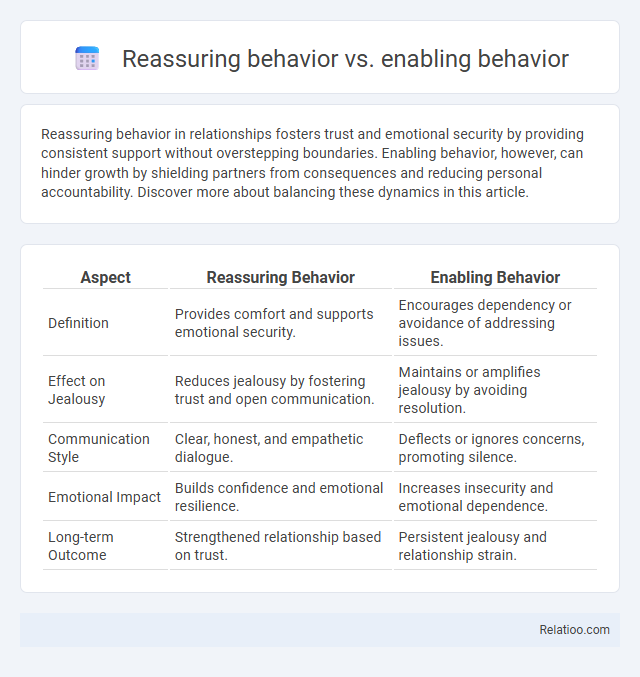Reassuring behavior in relationships fosters trust and emotional security by providing consistent support without overstepping boundaries. Enabling behavior, however, can hinder growth by shielding partners from consequences and reducing personal accountability. Discover more about balancing these dynamics in this article.
Table of Comparison
| Aspect | Reassuring Behavior | Enabling Behavior |
|---|---|---|
| Definition | Provides comfort and supports emotional security. | Encourages dependency or avoidance of addressing issues. |
| Effect on Jealousy | Reduces jealousy by fostering trust and open communication. | Maintains or amplifies jealousy by avoiding resolution. |
| Communication Style | Clear, honest, and empathetic dialogue. | Deflects or ignores concerns, promoting silence. |
| Emotional Impact | Builds confidence and emotional resilience. | Increases insecurity and emotional dependence. |
| Long-term Outcome | Strengthened relationship based on trust. | Persistent jealousy and relationship strain. |
Understanding Reassuring vs. Enabling Behavior
Understanding reassuring vs. enabling behavior is crucial for maintaining healthy relationships and personal growth. Reassuring behavior offers comfort and support without fostering dependency, helping you feel safe while encouraging independence. Enabling behavior, in contrast, often unintentionally supports harmful patterns by preventing accountability and fostering reliance.
Defining Reassuring Behavior
Reassuring behavior involves offering comfort and confidence to someone without fostering dependency, promoting their ability to face challenges independently. It differs from enabling behavior, which can inadvertently support unhealthy habits or prevent personal growth by shielding the individual from consequences. Understanding these distinctions helps you provide support that encourages resilience and self-efficacy rather than dependence or avoidance.
What is Enabling Behavior?
Enabling behavior involves actions that inadvertently support or protect someone from facing the natural consequences of their harmful choices, often preventing personal growth or accountability. This behavior can include making excuses, taking on responsibilities, or shielding others from challenges, which ultimately reinforces negative patterns. Understanding your role in enabling behavior is crucial to fostering healthier boundaries and encouraging responsible decision-making.
Key Differences Between Reassuring and Enabling
Reassuring behavior involves providing comfort and confidence to help someone face challenges independently, while enabling behavior unintentionally supports dependency by preventing the consequences of their actions. You can distinguish these behaviors by observing whether support promotes growth and responsibility, characteristic of reassurance, or fosters avoidance and reliance, typical of enabling. Key differences include the impact on personal accountability and the long-term effects on motivation and self-efficacy.
Psychological Impact on Individuals
Reassuring behavior provides emotional support that helps individuals feel safe and understood, fostering resilience and self-confidence. Enabling behavior, however, can undermine personal growth by encouraging dependency and preventing accountability, which may lead to increased anxiety and reduced self-efficacy. Your awareness of these dynamics is crucial for promoting healthier psychological outcomes and encouraging autonomy.
Common Examples in Daily Life
Reassuring behavior involves offering comfort and confidence to someone facing uncertainty, such as a parent calming a child before a test. Enabling behavior often appears when someone supports another's harmful habits, like repeatedly covering for a friend's missed work deadlines. Confusingly, reassuring and enabling behaviors can overlap when comfort unintentionally prevents accountability, such as a partner excusing frequent lateness while trying to reduce stress.
Risks of Excessive Reassurance
Excessive reassurance can lead to dependency, reducing an individual's ability to develop effective coping mechanisms and self-confidence, which impairs long-term emotional resilience. Enabling behavior often unintentionally supports unhealthy patterns by preventing individuals from facing consequences or addressing root problems, perpetuating dysfunction and hindering personal growth. Unlike enabling or neutral reassuring behaviors, balanced reassurance should empower autonomy while providing emotional support, minimizing risks of fostering reliance or avoidance.
Dangers of Enabling Problematic Behaviors
Enabling behavior involves supporting or facilitating problematic actions, often preventing individuals from facing the natural consequences of their behavior, which can lead to increased dependency and worsening of issues such as addiction or mental health struggles. Reassuring behavior, while providing emotional support and comfort, avoids shielding the individual from accountability, promoting healthier coping and recovery. The primary danger of enabling is perpetuating harmful patterns by removing motivation for change, thereby hindering personal growth and long-term rehabilitation.
Setting Healthy Boundaries
Setting healthy boundaries involves distinguishing between reassuring behavior, which provides comfort without compromising your limits, and enabling behavior, which inadvertently supports harmful patterns by excusing negative actions. Reassuring behavior promotes emotional support while maintaining accountability, ensuring your needs and well-being are prioritized. Understanding these differences helps you foster relationships that respect boundaries and encourage growth without dependency or tolerance of unacceptable conduct.
Strategies for Encouraging Positive Change
Reassuring behavior involves offering support and confidence to foster resilience, while enabling behavior inadvertently maintains negative patterns by shielding individuals from consequences. Encouraging positive change requires setting clear boundaries and promoting accountability to avoid enabling, coupled with consistent reassurance that empowers growth and self-efficacy. Strategies such as active listening, empathetic communication, and reinforcing progress help balance reassurance without enabling dependence.

Infographic: Reassuring behavior vs Enabling behavior
 relatioo.com
relatioo.com